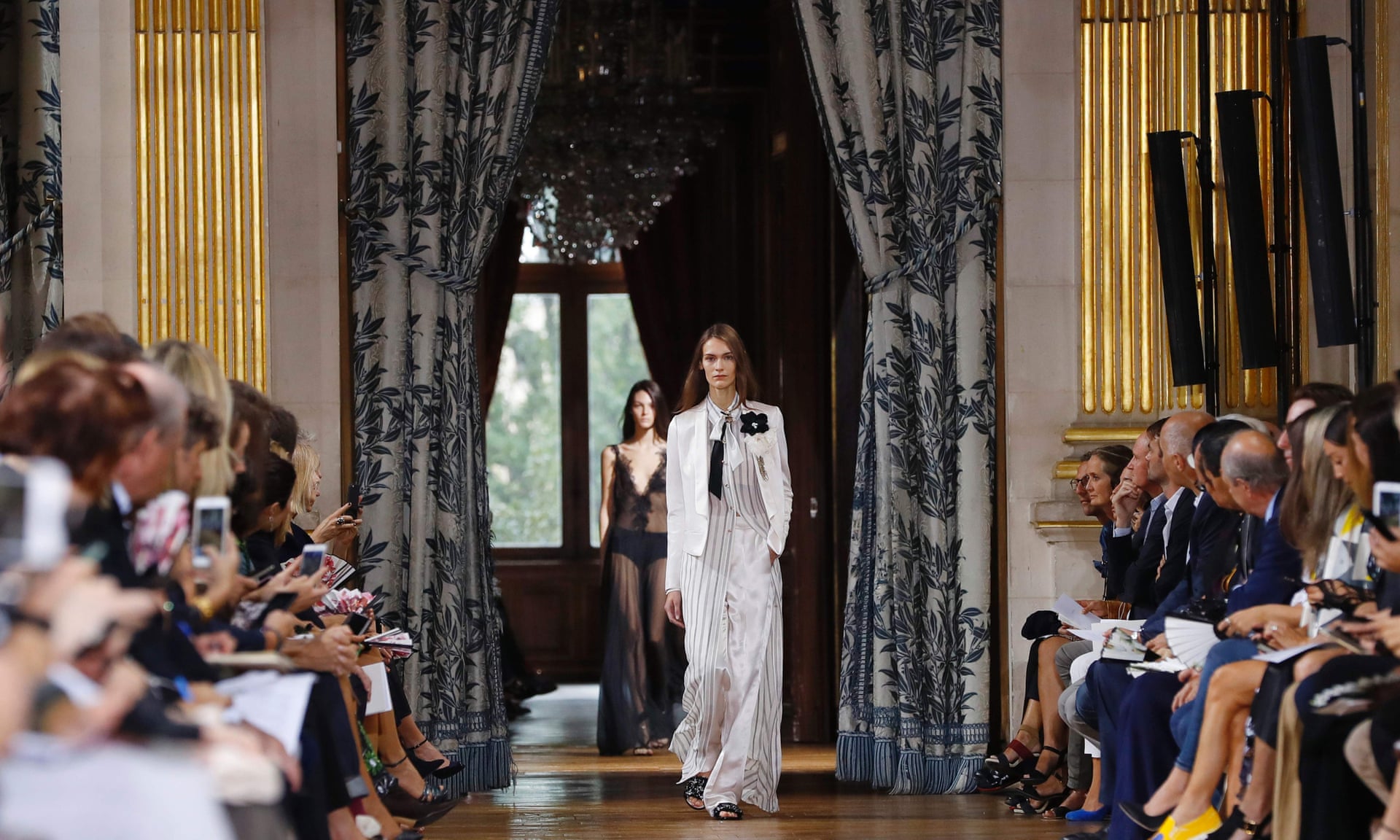Paris fashion week : Bouchra Jarrar shows she means business at Lanvin
New artistic director focuses on practicality and classic glamour at the Hôtel de Ville, a change perhaps inspired by falling profits
The Lanvin 2017 spring/summer ready-to-wear show on Wednesday. Photograph: Patrick Kovarik/AFP/Getty Images
First published in The Guardian
Bouchra Jarrar’s first show for Lanvin at Paris fashion week kicked off at noon on Wednesday, under bright lights at the Hôtel de Ville. This represents a shift for the French fashion house. Under the direction of Alber Elbaz for 14 years, Lanvin was always an evening show often soundtracked with disco. The time and place announced a new mood and the clothes in the collection were like night and day, too.
The first look was an ivory jacket worn over a satin shirt dress. This was followed by a chiffon kilt, pyjama suiting in pinstripes, floaty floral gowns and embellished vests. Most looks came with jewelled flowers pinned somewhere, and embellishment was everywhere.
These were clothes that fit into women’s lives – or the lifestyles of women who can afford luxury fashion, anyway. Nothing was even slightly avant garde: classic glamour was the general theme. A lot of the designs looked ready for the corporate balls of its wealthy customers, a white satin ruched gown, an asymmetric ivory dress with black sash, a black satin dress cut to skim the body, sandals with diamanté chain-mail cuff.
Some pieces had an off-duty feel, such as a loose embellished top with oversized cardigan and flat sandals, a biker jacket or tailored trousers. Critics might grumble about the lack of Elbaz-like runway razzle-dazzle, but real life has reached Lanvin in the hands of Jarrar.
Jarrar, dressed in a chic satin shirt and black trousers, answered questions backstage through a translator. While hugging her son, she said she found the legacy of Jeanne Lanvin – who founded the house in 1889, originally designing clothes for her daughter Marguerite – very inspiring.
“It was effortless to find the connection,” she said. “I wanted to mix the intellectual with the creative.” And the romantic, Jarrar was asked? “Tous jours,” came the reply. Jarrar was named artistic director of the house in March. “Her timeless style is in keeping with the style and the values of our company,” said chief executive Michèle Huiban.
The 45-year-old designer worked as the studio director under Nicolas Ghesquiere at Balenciaga and in the couture department of Christian Lacroix. She launched her own brand in 2010 and joined the couture schedule in 2013. Her designs quickly gained a cult following of women who liked the clean lines of minimalism at the top end of luxury.
Elbaz left Lanvin in October of 2015. His louche designs and comedic personality – complete with signature bow tie and spectacles – stood for Lanvin during his reign. He was much liked in fashion and at his HQ, with the Lanvin team protesting his departure. He has since described his exit as “his tragedy”. It is widely believed that Elbaz was pushed out of Lanvin by the house’s financiers, led by majority shareholder Shaw-Lan Wang who bought Lanvin in 2001, and originally recruited Elbaz.
Profits have certainly declined in recent years, from £10.25m in 2012 to £2.5m in 2014. In that context, Jarrar’s collection makes a lot of sense.
If Lanvin was about commerce, other shows on Wednesday were at the more artistic end of fashion.
Maison Margiela, under the direction of John Galliano, was a mash-up of sportswear and classic French staples. Trench coats were reworked as dresses and models in brightly coloured headgear wore outfits featuring wetsuits, boxing boots, camping gear and tweed suiting. It was an eclectic mix or, as the show notes said, a collection with “intrinsic strangeness”.
Dries Van Noten’s show is always a favourite of the arty-inclined fashion crowd. Huge photogenic bouquets of flowers frozen in ice, made by artist Makoto Azuma, dotted the catwalk. The show delivered clothes that would fit in at the crowds at London’s Frieze art fair. There were jet-beaded dresses and coats, chrysanthemum prints and wide coats with graphic prints akin to a De Kooning painting. A finale to an a capella of Madonna’s song Frozen was a fitting oddity that ensured Van Noten’s place in the art camp.
